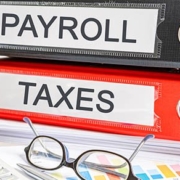AVOIDING TAX PENALTIES
Many tax penalties are substantial and can dramatically increase a tax bill. Penalties can be assessed for a variety of reasons. Some may result from a taxpayer’s carelessness or inattention to tax details. Other penalties are incurred due to the overstatement of deductions, the failure to report income, missing documentation, negligence or procrastination. Taxpayers may also be penalized for intentional acts of fraud and/or filing frivolous tax returns.
The following is an overview of the federal penalties that can be imposed on a taxpayer.
- Filing and Paying Late – These penalties will apply when a taxpayer fails to file taxes on time or does not pay the taxes he or she owes. The combined penalty is 5% of the unpaid tax for each month or part of a month that the return is late, but not for more than five months. The late-filing penalty is reduced if combined with the late payment penalty. Thus, the 5% includes a 4½% penalty for filing late and a ½% penalty for paying late.
The 25% combined maximum penalty includes 22½% for filing late and 2½% for paying late. The ½% penalty for paying late is not limited to five months. This penalty will continue to increase to a maximum of 25% until the taxpayer pays the tax in full. The maximum 25% penalty for paying late is in addition to the maximum 22½% late-filing penalty, bringing the total penalty to 47½%.
If a taxpayer does not file a return within 60 days of the due date, the minimum penalty is $135 or 100% of the balance of the tax due on the return—whichever is smaller.
- Underpayment of Estimated Tax – Our tax system is a “pay-as-you-go” system. To facilitate that concept, the government has provided several means of assisting taxpayers in meeting the “pay-as-you-go” requirement. These include:
• Payroll withholding for employees;
• Pension withholding for retirees; and
• Estimated tax payments for self-employed individuals and those with other sources of income not covered by withholding.When a taxpayer fails to prepay the required amount, he or she can be subject to the underpayment penalty. This penalty is 3% higher than the federal short-term interest rate, and the penalty is computed on a quarterly basis.
Federal tax law provides ways to avoid the underpayment penalty. If the underpayment is less than $1,000, no penalty is assessed. In addition, the law provides “safe harbor” (minimum) prepayments. There are two safe harbors, which are discussed below:
1. The first safe harbor is based on the tax owed in the current year. If a taxpayer’s payments equal or exceed 90% of what is owed in the current year, he or she can escape a penalty.2. The second safe harbor is based on the tax owed in the immediately preceding tax year. This safe harbor is generally 100% of the prior year’s tax liability. However, for higher-income taxpayers whose AGI exceeds $150,000 ($75,000 for married taxpayers filing separately), the prior year’s safe harbor is 110%.
- Dishonored Check – A penalty is charged if a taxpayer’s check is returned because of insufficient funds. For checks of $1,250 or more, the penalty is 2% of the check amount. For checks of less than $1,250, the penalty is the lesser of $25 or the amount of the check.
- Paying Late – The penalty is ½% of the unpaid tax for each month or part of a month that the tax is unpaid. If the IRS issues a Notice of Intent to Levy, and the taxpayer does not pay the balance within 10 days, the penalty increases to 1% per month. The penalty cannot be more than 25% of the tax that was paid late. The late payment penalty is reduced to ¼% per month for those paying in installments.
- Missing ID Number – This penalty is $50 for each missing number. This penalty is charged when a taxpayer does not provide a social security number (SSN) for himself, a dependent, or another person or does not provide his/her SSN to another person when required.
- Penalty for Unreported Tips – This penalty is charged if a taxpayer does not report tips to his/her employer. It equals 50% of the social security tax on the unreported tips.
- Negligence – This “accuracy-related” penalty is 20% of the tax underpayment that is due to negligence or tax valuation misstatements. 40% if attributable to undisclosed foreign financial accounts.
The “accuracy-related” penalty is imposed if any part of an underpayment of tax is due, either to negligence or a taxpayer’s disregard for rules or regulations but without intent to defraud. The penalty is 20% of the portion of the underpayment attributable to the negligence.
“Negligence” includes any failure to make a reasonable attempt to comply with the law or to exercise ordinary and reasonable care in preparing a tax return, as well as failure to keep adequate books and records or substantiate items properly. “Disregard” includes any careless, reckless or intentional disregard.
- Fraud – The civil fraud penalty is one of the most powerful tools that the IRS has. This penalty applies if any part of a tax underpayment is due to fraud, and the penalty equals 75% of that portion of the taxpayer’s underpayment attributable to fraud. Although the IRS has the burden of proving fraud with clear and convincing evidence, if it shows that any portion of an underpayment is due to fraud, the entire underpayment is treated as attributable to fraud except for any portion that the taxpayer shows (by a preponderance of the evidence) not to be attributable to fraud.
No time limit exists on the assessment and collection of tax if a fraudulent return is filed. Likewise, a return subject to the civil fraud penalty is treated as fraudulent for bankruptcy purposes. As a result, taxes shown on such a return are not normally discharged in a bankruptcy proceeding.
Although civil fraud is not defined by statute, some courts have defined it as an actual and deliberate, or willful, wrongdoing with specific intent to evade a tax believed to be owed.
- Fraud-Late Filing Penalty – The law allows the IRS to increase the penalty for filing late if a taxpayer did not file on time due to fraud. The penalty is 15% of the amount of tax that should have been reported on the tax return and an additional 15% for each additional month or part of a month that the taxpayer didn’t file a return. The penalty cannot exceed 75% of the unpaid tax.
- “Excessive” Claim Penalty – Generally, if a claim for a refund or credit for income tax is made for an “excessive amount,” the person making the claim is liable for a penalty equal to 20% of the excessive amount. The “excessive amount” is the amount by which the amount of a person’s claim for a refund or credit for any tax year exceeds the amount of the claim allowable under the Internal Revenue Code for that tax year. The penalty does not apply if it is shown by the taxpayer that the claim for the excessive amount has a reasonable basis or if any portion of the excessive amount or credit is subject to an accuracy-related or fraud penalty.
- Frivolous Return – In addition to any other penalties, the law imposes a penalty of $5,000 for filing a frivolous return. A frivolous return is one that does not contain information needed to figure the correct tax or shows a substantially incorrect tax because the taxpayer takes a frivolous position or desires to delay or interfere with the tax laws. This includes altering or striking out the preprinted language above the space where the taxpayer signs the tax return.
It is possible that some of the penalties listed above can be reduced or removed if a taxpayer can show reasonable cause. The IRS Penalty Handbook used by IRS agents defines reasonable cause as those reasons deemed administratively acceptable to the IRS: “Reasonable cause relief is generally granted when the taxpayer exercises ordinary business care and prudence in determining their tax obligations but is unable to comply with those obligations.” The Handbook also says, “Each case must be judged individually based on the facts and circumstances at hand.”








Leave a Reply
Want to join the discussion?Feel free to contribute!